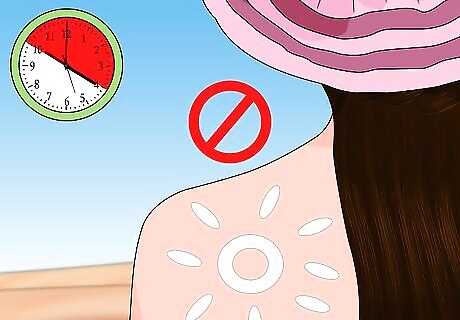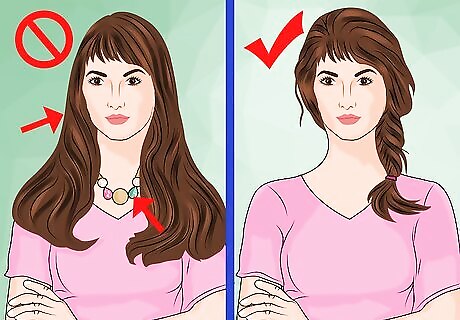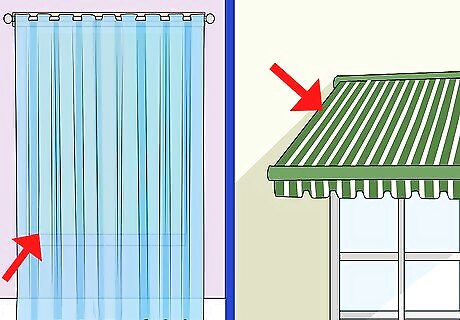
views
Eating and Drinking to Stay Cool

Stay hydrated. Water is essential for keeping you cool during hot weather. Water keeps your body cool and should be drunk even if you don't feel thirsty. It's okay to also drink commercial waters (such as Vitamin Water) or sports drinks such as Powerade or Gatorade but they're usually not necessary unless you're deliberately replenishing lost vitamins/electrolytes following a sporting activity. The best way to check your hydration level is to measure your urination color. Anything darker than straw colored is probably an indication that dehydration is on the horizon, and water is needed. Stay away from sugary drinks such as sodas(even if they are sugar-free!); they decrease the ability of your body to store water. Also, steer clear of alcoholic drinks, coffee, and caffeinated drinks, which are natural diuretics.

Don’t wait until you’re thirsty to drink. Drink plenty of water before engaging in any activities. If you wait too late, you could experience cramps, which are a sign of heat-related illness. Remind yourself to drink water frequently with one of the following options. Purchase a durable water bottle or water pack that you can tote everywhere and refill at any safe water tap. Freeze a bottle of water to carry around with you. It'll be solid when you leave the house, but the heat will start melting it from the moment you take it out of the freezer. Wrap it in a towel to prevent water condensation affecting other items in your bag. Download a water drinking app onto your phone. Set reminders, daily targets, and even track when the last time you had a drink.

Choose cooling foods. Food can keep you cool provided you make the right choices. Choose salads, fresh raw food, vegetables and fruit. “Cool as a cucumber” is literal; it is nearly 100% water, providing hydration to keep you cool. Avoid eating meat and protein-heavy foods during the heat of the day because these can increase metabolic heat production, which can add to loss of water. It may seem counter-intuitive, but eating spicy peppers may help cool you off. They make you sweat, which provides a cooling sensation. Smaller meals may also help keep your core temperature down. Large meals require the body to work harder breaking everything down.

Make food without using the oven or stove. Find foods that don’t need to be cooked, or don’t need heat to be cooked. If you must actually cook, keep the cool air in, and the temperature down, by using the microwave instead of the stove or oven. For example, you can microwave frozen vegetables and canned soup instead of cooking them on the stovetop. Cold soups are great in warm weather. If you haven't tried them yet, hot weather is the excuse you need! The fact they are often healthy is just an added benefit. Make popsicles, slushies, frozen fruit, frozen yogurt, and other frozen treats to help you cool down.
Protecting Yourself from the Sun

Stay out of the sun while it's at its hottest. This commonsense approach isn't always easy to adhere to when summer fun beckons, so it bears repeating. Avoid activities in the noonday sun as much as possible. It's best to limit your sun exposure between the hours of 10 a.m. and 4 p.m. each day during warmer months. When you are outside during these times, limit your exposure as best as you possibly can. Schedule activities early in the morning or later in the afternoon Some people are particularly vulnerable to heat and should stay in cool places during hot weather, such as children, the elderly, obese, redheads, gingers, and those who have health problems.

Wear sunscreen! While sunscreen doesn’t necessarily have a cooling effect, its protective effect is vital during warmer weather. As well as being painful and damaging, sunburn can cause a fever and various signs of dehydration. If left unchecked, sunburns can lead to heat exhaustion or heat stroke. At the minimum, use SPF 15. If you're planning on being outside for a while, SPF 30 would be a better option. Reapply often. Every two hours is recommended, but it should be reapplied more often if you're swimming or sweating a lot. Apply roughly a shot glass worth of sunscreen to cover the entire body.

Stay in the shade. Retreat to shade as much as possible. Taking breaks under trees works doubly well because trees release water into the air that absorbs some of the heat. While shade doesn’t lower the actual temperature, the lack of sunlight exposure makes it feel like the temperature is up to 15 degrees cooler. If a cool breeze comes by, that can feel like an additional lowering of 5 degrees in the shade.

Splash water on your skin. When it’s hot and sunny outside, a dip in cool water is refreshing. Jumping into a pool is not always a choice. Don’t forget low-maintenance options like sprinklers. You could also try taking showers or baths with cooler than normal water to take the edge off. Fill a spray bottle with pure water and place in the refrigerator at home or work. When you feel too hot, spray a fine mist of the cooled water over face and body to help cool you down quickly. Refill as needed and keep refrigerated. Make a game of staying cool. Gather friends and run through sprinklers. Throw water balloons. Have a squirt gun battle.
Dressing to Keep Cool

Wear lighter clothing. Lightweight, loose-fitting clothing will help to keep you cooler. If it is light in color, it’s even better, as this will reflect the heat and sunlight better. Shorts and short sleeved shirts are good choices. Something that lets the air flow freely through, hitting the sweat on your body, works best. The following suggestions are specific ways clothing can maximize your ability to stay cool: Cotton and linen clothing tends to keep you cool and absorb moisture. Clothes you can hold up to the light and see through are great choices. Be sure to apply sunscreen when wearing really thin clothing, however, as the clothing doesn't provide adequate protection from the sun's harmful rays. Synthetic clothing tends to trap moisture, which makes the fabric feel heavier, stick to your skin, and restrict air-flow. Working in lower humidity settings with short sleeves has been shown to have a minor benefit. Weigh the options of UV exposure with your choice of clothing.

Keep your head covered. Wear a wide-brimmed hat, one that sufficiently covers the top of your scalp as well as the tops of your ears. This helps to keep you cooler by providing shade. Choose a brim that is wide enough that it can also cover the back of your neck. Light-colored hats can help keep you cool.

Wear breathable footwear. Depending on the activity, one shoe could be more comfortable or appropriate than another. Consider whether arch support, durability, and comfort are mandatory, and then choose the best breathable footwear for the activity. Cotton socks are great, but moisture wicking socks help your feet stay cooler. Some running shoes are designed with the summer months in mind, providing ventilation in a variety of designs. Be careful if you decide to go barefoot. Many artificial pavements become unbearably hot during warm weather and can scald your feet.

Choose function over style. Wear fewer accessories during hotter weather. Metallic accessories can heat up considerably and less is always best when it comes to keeping cool. Other clothing accessories can weigh clothing down, trapping in heat and moisture. If you have long hair, wear it up and off your face and body, allowing the breeze to flow along your neckline.
Keeping Your House Cool

Use fans. While the efficacy of fans during extreme heat and humidity has been debated, some research suggests fans are beneficial up to 97 °F (36 °C) with 80% humidity, and 108 °F (42 °C) with nearly 50% humidity. Whether hand-held or electric, fans can keep you cool by continuously circulating air. In your home and office space, locate fans in rooms where you are working or resting to keep the air circulating freely and to reduce the mugginess of heat. Try making your own "swamp cooler." These evaporative coolers can reduce temperature by significant amounts. They range from the simple (i.e. a bowl of chilled water in front of a fan) to the semi-complex. With just a few PVC pipes, a bucket, an electric fan, and a frozen gallon of water, you can create mid-40 °F (4 °C) wind. However, keep in mind that swamp coolers will not work with humid heat. A fan should not be the primary source of cooling down in extremely hot weather. Fans work well, but only if the weather is not too hot.

Use air conditioning. Even if your home does not have central air, placing a small window air conditioner in one room of your home may help to keep it cool during the summer. For example, you could place the air conditioner in the room where you spend the most time, such as the living room, kitchen, or your bedroom. You can also try running the air conditioner at the highest comfortable temperature to avoid racking up a high electricity bill. Visit public buildings if you don't have adequate air-conditioning at home. A few possible locations to avoid the heat: The library is a great place to get cool and learn new information. Grocery stores are air conditioned well. And if it’s particularly hot, visit the freezer section and peruse for a while.

Close curtains and blinds. The sun’s rays convert to heat. However possible, you should block the rays coming into your house to keep the temperature down. Closing curtains, lowering shades, or even blocking windows can significantly reduce the heat in your house and keep it cool. Awnings work as well, because they keep the direct heat off the windows without blocking out all light.

Minimize the effects of sunlight on your roof. Changing the color of your roof can decrease the temperature in the house. Cooler colored roofs are approximately 50 degrees lower during hot summer months. You can put a special coating on your existing roof to lighten the color, or replace the traditional darker shingles with a lighter color. If you are interested in getting a special treatment for your roof to reduce the temperature in your home, then contact a roofing professional to find out about your options. You might want to wait until you need to replace your roof to make these changes.

Insulate well. Better insulation means less heat in the summer. If your house is hot, you can cool down easier with better insulation. Less crevices and avenues for the air to escape means the cool air stays inside. Ensure there is some air between insulation and roofing material.
Strategizing to Beat the Heat

Plan ahead. Whatever you're doing outdoors, having a plan will help cut down on unnecessary activity in the heat. By having a plan, you can set time limits on your exposure to the heat and plan ways to minimize the effects of the heat before you head into it each day. Always be sure to stick to your time limits by prioritizing and leaving less important things to be finished when it's cooler. When hiking, study the map at the beginning of the day, and calculate the best route, especially one that makes the most of shade where possible. While swimming, monitor your time in the pool. You may think there is minimal sun exposure because of the cooling effect of the water, but staying in too long without reapplying sunscreen or taking a break could lead to sunburn. If you have to travel a lot during hot days in your vehicle, plan ahead by having your vehicle inspected and ensuring that your air-conditioning is in working order. When you notice the temps aren’t as frigid as you’d like, take it in for service. The car is likely low on Freon.

Check local weather or news for updates. As part of your planning, spend time watching the weather forecasts. In the USA, NOAA produces a heat alert based on Heat Index Values. The importance of this measure is that it tells you how hot it will feel outdoors when the relative humidity has been factored in with the actual air temperature. Be aware that heat index values are devised for shady areas and light wind conditions. If you're under full sunshine and in the presence of strong winds, the heat factor can increase by up to 15 °F (−9 °C).

Allow yourself time to acclimatize if traveling. Travelers often make the mistake of trying to maintain normal levels of activity when arriving in a country warmer than the one they've left. Acclimatization can take up to 10 days depending on the temperature difference. Rather than pushing yourself, give yourself time to acclimatize to the new warmer environment, which means minimizing physical activity until the heat feels more tolerable. Once you feel more comfortable in the heat, gradually build up your physical activities until you're back to your normal level.

Pace yourself when working in the heat. Slow down, it's not worth pushing yourself strenuously when it's hot outside. Start and progress gradually, noting when the heat is really affecting you. Rest is an important way of coping with too much heat. Don't deny yourself the opportunity to rest when you feel fatigued during warm weather. Things that require a lot of physical effort can be done early in the morning or later in the day.















Comments
0 comment